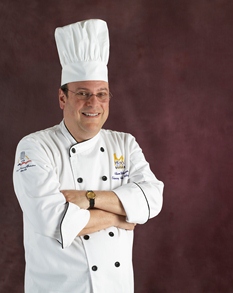Teaching Presentation in 50 Minutes
Thursday, 01 January 2009 03:00
 One thing that separates professional cooks from their moms is how they present food. Here are five things students should remember when plating
One thing that separates professional cooks from their moms is how they present food. Here are five things students should remember when plating
By Adam Weiner, JobTrain and the Sequoia Adult School
Students new to cooking go through three stages of trauma. First, they worry about making enough food; second, they agonize on how the food tastes; and finally, they stress about how the food looks. Much of the presentation pain comes from most of the new generation of cooks experiencing “presentation” as bags of fast food in a car seat and “plating” by ordering at the mall’s food court.
I have found the best way to minimize the pain of the third stage is to tell students not to prepare anything until they have in their minds (or better yet, a drawing on paper) how the final plate will look.
Students think this is strange. They feel that if they start cooking, the plating and presentation will fall into place. I explain that if I asked them to build a car, they wouldn’t just pick up some screws, tires, sheet metal and glass and start hammering. They would first have a picture of the finished car. To build a car or a plate of food takes a picture and a plan.

 Center-of-the-plate proteins, including American lamb, are the focus of this lesson plan for freshman in the Associate of Applied Science degree program at Southern Maine Community College in South Portland. The course, of which this lesson is a part, addresses the basic fabrication of meat, fish and poultry; stocks; the five major sauces; derivative sauces; coulis, jus lié, and reductions. The class covers moist and dry methods of cooking that demonstrate appropriate cooking methods for a wide array of products.
Center-of-the-plate proteins, including American lamb, are the focus of this lesson plan for freshman in the Associate of Applied Science degree program at Southern Maine Community College in South Portland. The course, of which this lesson is a part, addresses the basic fabrication of meat, fish and poultry; stocks; the five major sauces; derivative sauces; coulis, jus lié, and reductions. The class covers moist and dry methods of cooking that demonstrate appropriate cooking methods for a wide array of products.  As the demographic of culinary schools shifts to a much more multicultural environment, embracing and celebrating cultural diversity is becoming part of the everyday life of culinary institutions. The challenge for culinary instructors is in finding a way to integrate cultural diversity into the curriculum in a tacit manner, one in which students might not recognize the true objectives, yet at the same time, achieve a sense of accomplishment and pride in their own cultural heritage and cuisine.
As the demographic of culinary schools shifts to a much more multicultural environment, embracing and celebrating cultural diversity is becoming part of the everyday life of culinary institutions. The challenge for culinary instructors is in finding a way to integrate cultural diversity into the curriculum in a tacit manner, one in which students might not recognize the true objectives, yet at the same time, achieve a sense of accomplishment and pride in their own cultural heritage and cuisine. Shirley P. Rauh, FACS chair at Lutheran High School South in St. Louis, submitted the following Lesson Plan as a “teaching tip” entry in the 2007 CAFÉ Scholarship program that awarded four winners grants toward registration at a CAFÉ workshop or the Leadership Conference this summer.
Shirley P. Rauh, FACS chair at Lutheran High School South in St. Louis, submitted the following Lesson Plan as a “teaching tip” entry in the 2007 CAFÉ Scholarship program that awarded four winners grants toward registration at a CAFÉ workshop or the Leadership Conference this summer.  This comprehensive lesson plan provides a basic understanding of American lamb, with a particular focus on the leg, from farm to plate. Topics include product acquisition, leg cuts and fabrication, safe handling and sanitation, best applied cooking techniques and methods, nutrition, and ideal flavors to marry with American lamb, as well as discussion questions.
This comprehensive lesson plan provides a basic understanding of American lamb, with a particular focus on the leg, from farm to plate. Topics include product acquisition, leg cuts and fabrication, safe handling and sanitation, best applied cooking techniques and methods, nutrition, and ideal flavors to marry with American lamb, as well as discussion questions.  Presented by Avocados from Mexico
Presented by Avocados from Mexico Contrary to popular belief, the mango is available any time of year, and the Orlando, Fla.-based National Mango Board (NMB) has made it its mission to educate U.S. consumers on selection and preparation of the world’s most consumed fruit. Since 1995, mango consumption has increased by 100% in the United States (U.S. Outlook Report 2004). Approximately only 30% of U.S. households consume mangos today, however.
Contrary to popular belief, the mango is available any time of year, and the Orlando, Fla.-based National Mango Board (NMB) has made it its mission to educate U.S. consumers on selection and preparation of the world’s most consumed fruit. Since 1995, mango consumption has increased by 100% in the United States (U.S. Outlook Report 2004). Approximately only 30% of U.S. households consume mangos today, however.